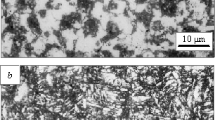Conclusions
-
1.
Electrothermal treatment (electrohardening+electrotempering) of complex alloy steel 8Kh4V2S2MF increases the hardness to HRC 65-67.
-
2.
Electrothermal treatment (hardening with holding 20 sec at austenitizing temperature and electrotempering) of ledeburitic steel Kh12M makes it possible to obtain a hardness of HRC 61-63.
-
3.
To obtain a long service life for tools subject to large alternating loads it is expedient to have some amount of retained austenite in the structure.
Similar content being viewed by others
Literature Cited
Yu. A. Geller, V. F. Moiseev, and G. A. Okolovich, "Fundamentals of alloying cold-worked die steels subjected to secondary hardening", Metalloved. Term. Obrab. Met., No. 2, 9, (1973).
Yu. A. Geller, Tool Steels [in Russian], Metallurgiya, Moscow (1975).
G. V. Kozyrev and G. V. Toporov, "Effect of retained austenite on the impact fatigue strength of steel", Metalloved. Term. Obrab. Met., No. 12, 45 (1973).
Additional information
Translated from Metallovedenie i Termicheskaya Obrabotka Metallov, No. 11, pp. 54–56, November, 1978.
Rights and permissions
About this article
Cite this article
Kholin, A.S., Abramov, A.I., Chekhovoi, A.N. et al. Electrothermal treatment of high-alloy die steels. Met Sci Heat Treat 20, 936–938 (1978). https://doi.org/10.1007/BF00713761
Issue Date:
DOI: https://doi.org/10.1007/BF00713761




